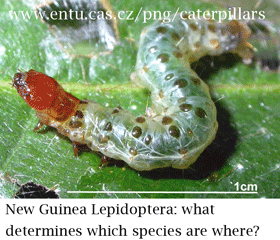DNA barcoding efficiently identifies species from flies to fish to flowers, including from bits and pieces and other unrecognizable forms: eggs, larvae, seeds, pollen, roots, damaged museum specimens, and even DNA shed into aquatic and terrestrial environments. What else can we do with this new instrument? With the BOLD reference library at >800,000 records from > 68,000 species, DNA barcoding combined with high-throughput sequencing can be a macroscope for studying large-scale patterns in biodiversity.
 In March 2, 2010 Proc Natl Acad Sci USA researchers from University of Minnesota, National Museum of Natural History, University of Guelph, and University of South Bohemia, Czech Republic, apply DNA barcoding to measure species diversity and distribution in tropical moths and butterflies. In an earlier study (Novotny et al Nature 2007), some of the same researchers had shown surprisingly low beta diversity and little host specialization in herbivorous insects across 75,000 square kilometers in lowland rainforest in Papua New Guinea, an area 1 1/2 times as large as Costa Rica. (Note: alpha diversity is number of species at a given site; beta diversity refers to differences in species composition among sites).
In March 2, 2010 Proc Natl Acad Sci USA researchers from University of Minnesota, National Museum of Natural History, University of Guelph, and University of South Bohemia, Czech Republic, apply DNA barcoding to measure species diversity and distribution in tropical moths and butterflies. In an earlier study (Novotny et al Nature 2007), some of the same researchers had shown surprisingly low beta diversity and little host specialization in herbivorous insects across 75,000 square kilometers in lowland rainforest in Papua New Guinea, an area 1 1/2 times as large as Costa Rica. (Note: alpha diversity is number of species at a given site; beta diversity refers to differences in species composition among sites).
For the Nature report, the researchers hand-collected 74,184 caterpillars representing 370 species; each caterpillar was tested for food preference in the field, and 25,346 were raised to adults. In the PNAS study, the researchers analyzed COI barcodes of 1,359 individuals representing 28 apparently widespread Lepidoptera species for which they had collected large numbers of individuals at 8 sites across the region (average individuals per species, 49, range 29-80; average sites per species, 6.1, range 3-8; average distance between sites, 160 km, range 59 -513 km).
Craft and colleagues found “no universal pattern of population genetic structure among 28 Lepidoptera species in lowland New Guinea.” Although about half of the species showed genetic diversity associated with host plant specialization and/or geographic isolation (some of the variant lineages may represent distinct species), the phylogeographic patterns differed among species and there were a surprising number of widely sympatric species with overlapping diets, a challenge for ecological theory. As the authors note, their results contradict estimates of insect diversity and host specialization in the Americas, and they call for “comparative population genetics of ecological guilds” to enable testing “major hypotheses for the origin and maintenance of species diversity.” Like a new telescope for astronomy, DNA barcoding offers biologists a new instrument for exploring the structure of biodiversity.